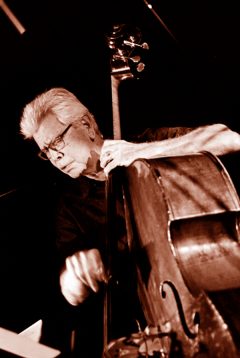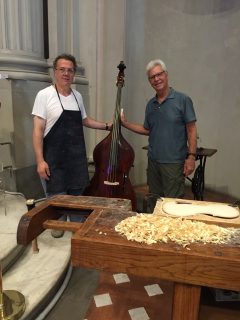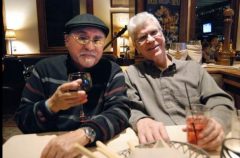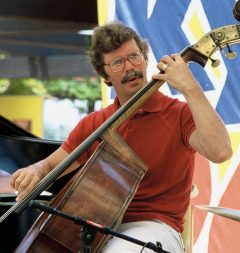Featured Stories
In Praise of Bob Magnusson
I’ll never forget the fist time I heard Bob Magnusson play the bass. Oh my gosh, what a sound! He could make a whole note sing with a liquid sheen or turn around and make that whole note growl like an unfed Doberman.
Aside from the pure sonic beauty of his sound–Bob’s sense of time–his ability to swing always seemed to inspire his bandmates. He had that ability to “lift the band stand,” as the great Steve Lacy once opined.
I used to catch him often after he moved back to San Diego in the early ’80s, after spending about a decade up in Los Angeles, playing with everyone from Sarah Vaughan to Art Pepper to Joe Farrell, and that’s just the tip of the iceberg.
Both of Bob’s parents were classical musicians and Bob himself spent 12 years studying the French horn, an instrument that requires the player to develop a superior sound. “Most of my teachers really got me to work on producing a rich tone,” he told me recently, when I inquired about the possible connection between his early relationship with the horn and that beautiful tone he gets on the double bass. “You might be right about that,” he admitted. “I’ve always worked on getting a rich, singing tone, and I’m sure all those years and all of those teachers played a hand in that.”
Yes. Since meeting Bob in the mid-1970s, YES is still the first thought that comes to mind whenever thinking about him. Most of the great lessons I have learned in life have come from my elders. However, there are a few special people closer to my own age group, as peers, who have had a great and lasting influence on my life. Bob Magnusson is one of those special people. I doubt Bob is aware of this but for the past 44 years, his modeling of real integrity during the years we interacted in Los Angeles continues to make a big difference in my life, especially when adversity has knocked on my door.
Kindness, respect, generosity, patience and love just flow from him in a natural way. Playing music with Bob was always an event that I looked forward to. His great time, clear sound, and vivacious spirit never failed to put a smile on my face. Thank you for all of the above, Bob.
–Joey Baron, drummer
Bob probably would have stuck with classical music, which he loved. “My parents never played any pop music around the house. But my older brother drafted me into his rock band to play electric bass and I loved it. From there I joined a very good R&B band [George Semper and the Kingsmen] and began to be exposed to jazz, mostly a funky, blues style. One day one of the guys gave me a copy of the Miles Davis record Kind of Blue and my whole life changed in an instant. All of a sudden, the two things I loved the most–the harmonies of the French Impressionists and the groove of the blues–came together! I was immediately hooked and I started thinking about playing the double bass. It turns out that my mom had played bass in school and there was an old one stored under the house, It was in pieces but I was working as an apprentice at a cabinet shop and the older guys assured me they could put it back together good as new. They rebuilt it and did a wonderful job, except that they used regular wood glue and they finished it with three coats of lacquer, all things you should definitely not do.”
So Bob took up the bass, and to say that he made rapid progress is perhaps the ultimate understatement. In two years, he had moved to Las Vegas where he ultimately landed a job with the notoriously volatile drummer/bandleader Buddy Rich.
Bob Magnusson’s sound, those long singing lines and lithe, springy beat was arguably the state-of-the-art of jazz bass, certainly on the West Coast in the ’70s. He had more than anyone I had encountered,figured out how to play the bass with an amplified sound and an on-top-of-the-beat placement, so profound it could drive a band with just pure musicality. His sound was completely modern, and his tone concept was almost horn-like. With Bob each tone was a pearl, perfectly formed and strung together in a poetic whole.
–Mark Dresser, bass.
Once Bob got off the road with Rich, he managed to get the opportunity of a lifetime: to wit, a two-week engagement with vocal legend Sarah Vaughan, replacing Canadian bass heavyweight Gene Perla in a trio that featured Jan Hammer on piano and Jimmy Cobb on drums. I guess I should say at this point that Jimmy Cobb is the drummer on Kind of Blue, the album that changed Bob’s life.
It’s hard for me to imagine how talented Bob must have been to have taken up the bass so late in life and, a few years later, to land in a band of such stature. That is surely a testament to his innate musicality. After the two weeks were up, Sarah summoned Bob to her dressing room. “She offered me the gig, and asked me how much money I would need. I had never made more than $250 a week with Buddy, so I decided to get brave and ask Sarah for $350 a week. She just started laughing, and I was getting embarrassed, thinking she was making fun of me for being greedy. Then she looked at me and said, ‘Bob, the other guys are making $500. So are you!’’’
He’s got one of the most iconic bass sounds you’ll ever hear–even if he’s playing someone else’s instrument, you still know it’s him. When I was a younger player, he was an incredible mentor to me. He got me on tons of gigs in L.A. and down here as well. He introduced me to Chick Corea, which was absolutely huge at the time. He’s one of the kindest and most thoughtful people I know. He’s so humble and kind and I’ll never forget all of the things he did for me.
–Peter Sprague, guitar
I had to ask Bob what it was like playing in a band with Sarah Vaughan and his hero Jimmy Cobb. “It was an incredible honor, but at the same time it was terrifying! I just knew that if I placed my beat where Jimmy was, I would be learning how to play jazz with a master. He’s a wonderful guy; he never told me what to play or offered me any advice. He’s really quiet in his own way. I played with Sarah for three years altogether during two stints. Eventually Jan Hammer left the band to become a founding member of the Mahavishnu Orchestra!”
Bob didn’t learn to play jazz in an academic setting, he learned by playing gigs with older, wiser and more experienced players. This is not to say that he didn’t study–he had many great teachers (including Bert Turetzky) throughout his career. But for modern students of jazz, who have fewer opportunities to learn music from the apprenticeship model, having access to a guy like him is a great resource. Everything you learn from him is grounded in some pragmatic origin. It’s all coming from something he learned or needed to know on a gig.
–Mackenzie Leighton, bass (former student)
It was during that time with Sarah Vaughan where a central idea behind the famous Bob Magnusson sound was created–and his relationship with Jimmy Cobb was directly responsible for it. “Sarah used to play these ballads like ‘Round Midnight’ really slow, I mean I had never played so slow before, except maybe in an orchestra with a conductor. I was really struggling with what to do, and nothing was working. Finally one night after the gig at the bar I told Jimmy what a hard time I was having, and he said, ‘Bob you’ve got such a beautiful long sustain, why don’t you let a whole-note die out on its own?’ Well, this is Jimmy Cobb talking, so the next night I tried it and it was like someone was pouring warm honey from a jar! It was rich and it thickened up the time just beautifully!
I think the first time I saw Bob Magnusson perform was in the early 2000s in a group with Peter Sprague at the old Dizzy’s downtown. I was immediately impressed and inspired by his bass playing. From the beginning, I’ve always admired the clarity of his pitch, his melodic approach to improvising and his musical versatility. I learned a lot about playing the bass from watching and listening to Bob perform. Over the years I’ve gotten to know Bob more personally and have learned that he is probably one of the friendliest and most consistently positive people you’ll ever meet.
–Justin Grinnell, bass
Bob moved to L.A. at the suggestion of Sarah Vaughan, because she wanted to use the city as a base from which to tour the world. She even helped him and his young family make the move. “I wasn’t sure I could afford it, but she told me to find a house and then call her business manager. She paid for it and told me I could pay her back over time. When I wasn’t busy with Sarah, I started making other connections. When I was with Buddy Rich, I had met Art Pepper, who told me to look him up if I ever made it to L.A., and he was true to his word, so I began playing with Art for several years. Those were great years for me in L.A., but I grew up in Point Loma, and I realized I wanted to raise my kids by the ocean, so in 1983, we decided to move back to town, and I’ve been really happy ever since. There really is no place like home!”
First of all he’s a great guy–a straight shooter. We’ve been playing together so long–and I always knew I was dealing with a genius. I was aware of his resume, of course, all of the heavy- duty people like Joe Pass, and Benny Golson that he had played with by the time he came back to San Diego. One thing that really made an impression was that it didn’t matter whether we were playing for a full house or just for the bartender. Bob gave it his all regardless and I’ve been spoiled by that because not everyone is like that. Bob never needed feedback from a big crowd to perform at his best. I know the sound of his bass no matter what. I can hear him on the radio and identify that sound immediately. I’ve sat right next to him on hundreds of gigs and I’d know that sound anywhere.
–Jaime Valle
I consider myself very fortunate to have grown up as a jazz fan in the era of Bob Magnusson, I’ve probably seen him on close to a hundred gigs in the last 40 years since I became aware of his playing in the late ’70s. I’ve derived so much pleasure from taking in that beautiful, fat tone and that incredibly propulsive time. I’ve got dozens of albums that he completely illuminates and I was saddened to hear the news of his retirement, but I could also kind of tell that he was not feeling well.
It turns out that Bob has been suffering from a very severe form of arthritis for over a dozen years, and the effects of this condition have slowly affected his ability to play the instrument at the level that we have all come to love. “The doctors told me that I basically had no cartilage left in my hands. It can be very painful. So first, I had to stop practicing–I was able to do that for a while, but I had these nightmares about failing, which became a self-fulfilling prophecy. I started taking fewer and fewer gigs, and I actually performed in public for the last time recently.”
Bob still teaches, and he’s able to grab the bass from a student momentarily when he needs to teach by example, but his days of thrilling audiences with that one-of-a-kind sound are unfortunately over. Despite that, he’s not a “woe-is-me” kind of guy.
“I do miss the camaraderie,” he admits. “But I’m such a lucky guy. Nowadays I get such pleasure from watching some of my former students like Mackenzie Leighton, Harley Magsino and Sean Hicke perform. I’ve got my family and wonderful friends. Life is good.”
Bob’s influence as a bassist and educator has been felt internationally by the music community. His fluid sound and modern melodic approach brought a new dimension to bass playing and helped move the instrument into new sonic realms. I first met him at the Bass Institute in L.A., where he was incredibly supportive as a teacher. He’s a very caring person as well, and I feel honored to have him as a friend.
–Rob Thorsen, bass










